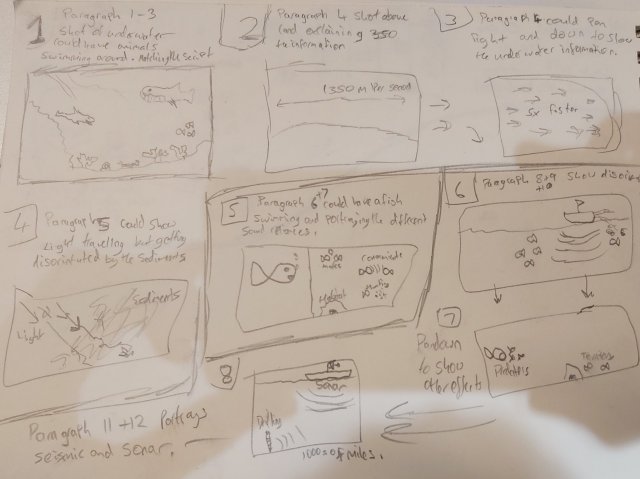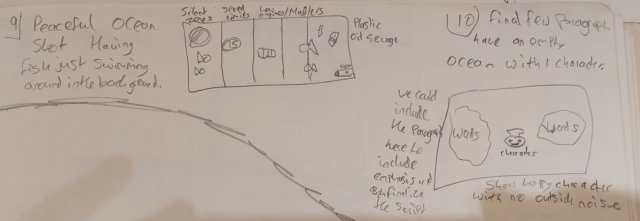Today I finalized my script for the Noise Pollution On Marine Wildlife animated documentary. I had used the draft I had created a while ago and went through it to pick out the crucial points of information and structure it in order to create a successful and effective script. I included an Overview, Why Marine Wildlife Need Sound, What Noise Pollution Does and How We Can Help. With these headings it covers the whole area and provides the audience with enough information to understand and know a lot about it and how to fix the issue. I have structured the script also to be presented in short paragraphs and sentences to allow a much easier read for us and to split up the different sections of information effectively. I have posted the final script and draft to the Trello page along with a description with what I have done. I am open to changing things if my group arent satisfied or fell as if I have included too much or missed something out. Along with this we have a meeting at 4:30pm with a man from America who is knowledgeable in this topic so hopefully he can give us a lot of more insight and useful and unique information to include in our aniamted documentary. The final script can be found below!
Overview – Part 1
There is a reason to why the ocean is referred to as the ‘silent world’. In this world, where sounds are crucial to survival, there is no room or need for foreign sounds to breach the harmony of this unique world.
Sensitivity of various marine animals to ocean noise pollution is varying. While cetaceans like whales and dolphins may show a greater resistance, soft shelled species like molluscs, prawns and fish are much more sensitive.
Exposure to foreign noise during the embryonic stage increases sensitivity of fish to the noise impact, increasing the mortality rates at time of birth and development of genetic anomalies.
The type of medium determines the speed of sound. On land sound travels at 350 metres per second. In the ocean, sound travels much faster around 5x the speed as on land and longer.
This is the reason that marine creatures rely on hearing much more than other senses such as sight. Light for example can only travel a few hundred metres underwater before getting absorbed and scattered. Along with the sediments found in the ocean this can limit long range vision, like looking through fog on land.
Why Marine Life Need Sound – Part 2
Marine wildlife throughout the years have evolved a perfectly tuned sense of hearing. There have been species of blind fish and amphibians but never deaf which shows how important hearing is to survival if you live in the ocean.
The sound is relied on to listen, find habitats, navigate, find mates and communicate with each other when hunting or to avoid being hunted.
How It Effects Marine Life – Part 3
But whilst nature’s sounds travel so does man-made noise, which can easily drown out the natural ocean soundscape, making it difficult for fish to hear one another. This affects their ability to find food and mates, causes stress and changes their behaviour.
In busy shipping lanes, scientists have even come across physical damage in the largest of our planet’s mammals the whales.
More scientists are discovering that noise not only interferes with an animal’s cognitive processing of sounds, but also other types of stimuli, such as sight or smell. For example, boat noise interferes with the visual signals that cuttlefish use to communicate with each other.
Climate change, overfishing and run-off pollution threaten fish populations in the Great Barrier Reef, but our study adds to the growing evidence that boat noise may also contribute to fish death through a failure to learn.
Boat noise can have a variety of negative impacts on fishes. It can change their activity, force them to live in bad habitats and decrease their ability to feed, defend their territory, reproduce and avoid predators.
How to Help and Prevent – Part 4
We want to draw attention toward this issue and know of ways to reduce and solve the problem. Such as agreeing and sticking to a set of principles to reduce noise impacts worldwide, along with making the noise less painful.
In some places, such as biodiversity hotspots or sensitive habitats, it may be prudent to create rules or laws that minimize the impacts of noise.
These laws could include silent zones and speed restrictions along with the use of lower powered engines and mufflers.
Unlike other pollution that enters our water, noise pollution is the easiest to tackle. Once the noise stops, it’s gone. We’re not left with detritus that continues to pollute and kill marine life for decades to come, as with plastic, oil and sewage.
In terms of manageability, we can do a much better job with solving this problem. And if we can solve this problem, that’s one less crisis to worry about our oceans.
Humans rely on the ocean for its biodiversity and natural resources. It also plays a fundamental role in regulating atmospheric temperatures and gases.
Today’s seas continue to face these threats, as well as from habitat destruction, warming and ocean acidification.




